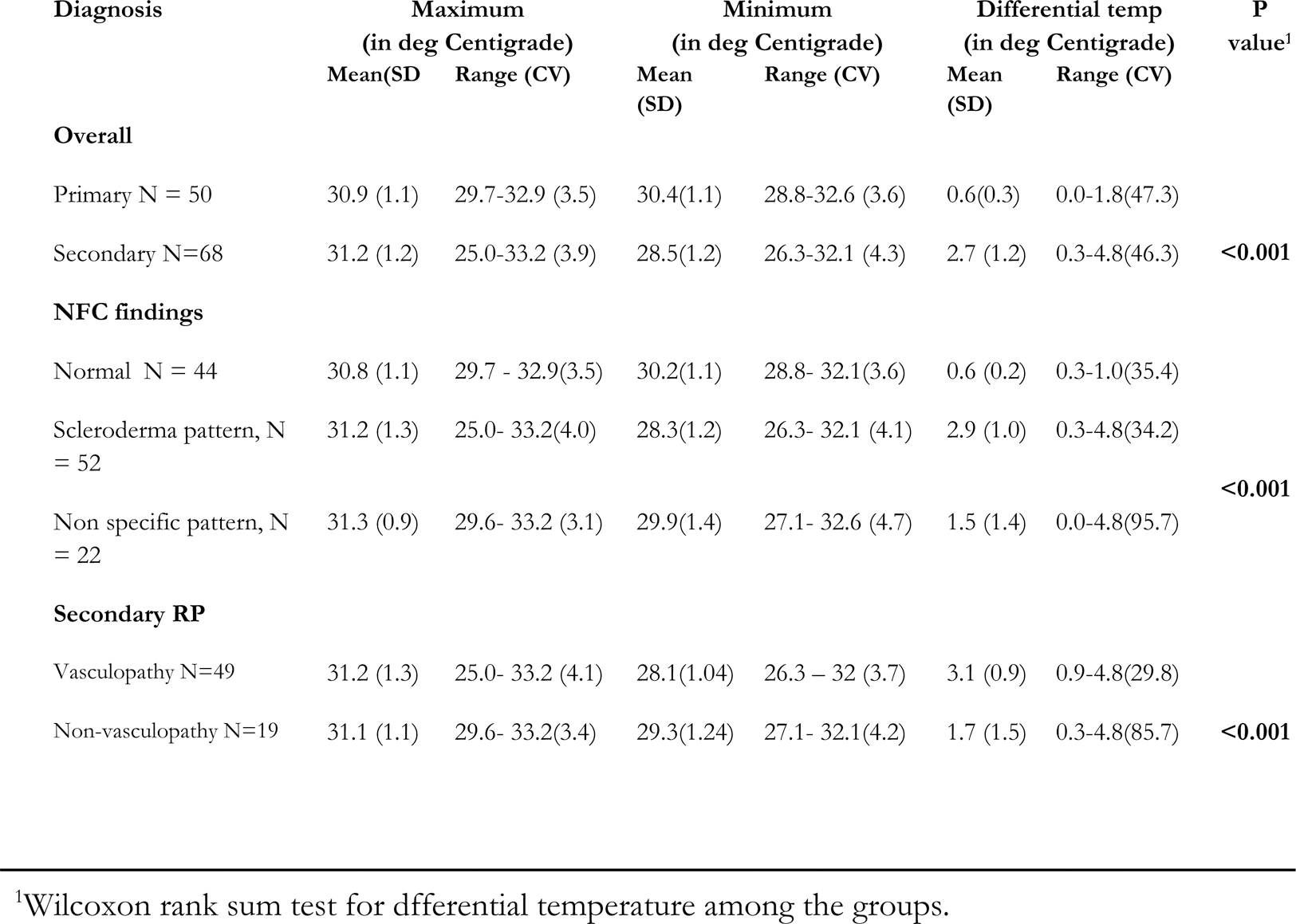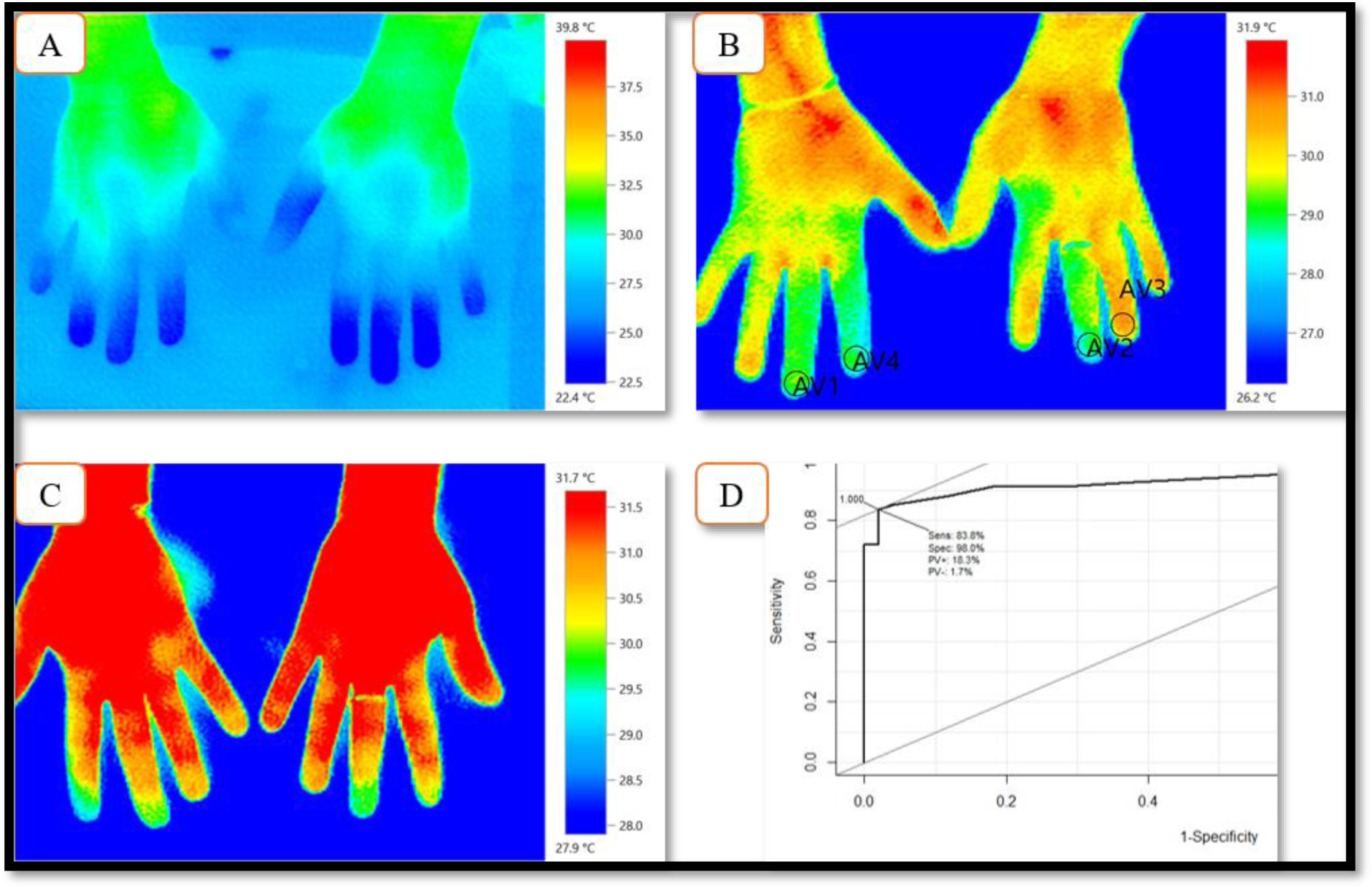

Background: Raynaud’s phenomenon (RP) is a common symptom characterized by episodic digital ischemia with color changes on exposure to cold. It is imperative to distinguish between Primary RP (pRP) which is a benign condition from secondary RP (sRP) owing to its association with serious Connective tissue disorders (CTD). The available tools for differentiating between the two entities are clinical as well as laboratory-based tests including Antinuclear antibody and Nailfold capillaroscopy (NFC). All these tools have inherent limitations and require technical expertise for evaluation and interpretation. The relative changes in temperature of hand digits are characteristic of RP and Infrared thermal imaging (IRT) can be utilized as a simple, objective tool to assess the same.
To evaluate the ability of IRT to distinguish between pRP and sRP
To estimate an optimal cut off for differential temperature(DT) in digits to differentiate betwen pRP and sRP
Methods: A cross-sectional diagnostic test study for adult RP patients was conducted at a tertiary care hospital in India. Those with severe manifestations, ongoing complications or on medications for RP were excluded. The participants were classified into pRP and sRP based on clinical and investigation findings by a Rheumatologist. The sRP subjects were further classified into vasculopathic CTD(VCTD) and non-vasculopathic CTD (NVCTD). The VCTD included Systemic sclerosis, Mixed connective tissue disorder, dermatomyositis and overlap syndromes. NFC was carried out to categorize participants with normal, nonspecific and scleroderma pattern. For IRT, hands were exposed to 10 deg Centigrade temperatures in water bath for a few minutes followed by rewarming with hot air hand dryer for 3 minutes. The IRT of hands was carried out 05 mins after rewarming of hands by a thermal camera. The area of interest (AOI) was skin overlying terminal phalanx for each digit where average temperature was calculated with software. The DT was defined as the maximum difference between AOI of all digits.
Results: A total of 118 patients with a mean age of 32 years were analyzed and majority were males (n = 96). The wide difference in temperature between hand digits in sRP patients can be easily appreciated on IRT camera display and objectively evaluated on software (Figure 1). Table 1 represents the comparison of DT in various subgroups (pRP vs sRP, NFC findings and vasculopathies). The mean DT was significantly higher among patients with sRP, scleroderma pattern, and VCTD (p < 0.001). The sRP and VCTD group had shown statistically significant DT as compared to pRP and NVCTD, respectively. The NFC findings of scleroderma pattern had statistically significant higher DT as compared to normal and non-specific pattern. The optimal cutoff to differentiate pRP from sRP was one degree temperature difference with a sensitivity of 83.8 percent and specificity of 98 percent with AUC of 0.93 (Figure 1). For a cut-off of DT of 1 with a Youden index of 0.79, the diagnostic accuracy of IRT was 0.89 and number needed to diagnose was 1.25.
Conclusion: RP is a common symptom in general population and the diagnosis of sRP is imperative owing to its association with CTD. The present study highlights the role of IRT as a simple, cost effective and easy to interpret bedside tool with a potential for differentiating between pRP and sRP. This study infers that a cut-off of DT of 1 deg Centigrade can be utilized in clinical practice to differentiate between pRP and sRP. The study also highlights significant differences in DT between VCTD and NVCTD.
REFERENCES: NIL.
Table 1. Comparison of digital temperatures amongst various subgroups

Infrared thermal images of hands in a subject and ROC analysis
A) During an episode of Raynaud’s phenomenon
B) Depicting area of interest for recording average temp of digits.
C) Showing asymmetrical distribution of temp in distal segments of digits during recovery from Raynaud’s phenomenon
D) ROC analysis of optimal cut-off point for differential temperature

Acknowledgements: NIL.
Disclosure of Interests: None declared.